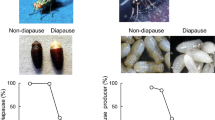Summary
-
1.
Larvae ofSarcophaga argyrostoma raised in continuous darkness (DD) and in ‘square-wave’ temperature cycles or thermoperiods (Hot:Cold4:20 to20:4, whereH=25 °C and C=15 °C) entered pupal diapause at a rate equivalent to that in DD and a constant temperature equal to the arithmetic mean of the cycle. Therefore, unlike many other insects so tested,S. argyrostoma appears to show no thermoperiodic regulation of diapause induction.
-
2.
A daily low temperature pulse (3 h at 5 °C; =HC21:3), however, had marked phase-dependent effects on diapause incidence when administered with a concomitant light cycle (LD14:10), diapause increasing when the cold pulse fell early in the night, but decreasing when late in the night. This result is interpreted in terms of the phaseresetting effects of the cold pulse on the circadian oscillations making up the clock.
-
3.
These results are considered to be consistent with an ‘external coincidence’ model for the photoperiodic clock and appear to differentiate between the ‘internal’ and ‘external’ alternatives (forS. argyrostoma) by demonstrating an inductive requirement for light in addition to that for entrainment.
Similar content being viewed by others
References
Beck SD (1982) Thermoperiodic induction of larval diapause in the European corn borer,Ostrinia nubilalis. J Insect Physiol 28:273–277
Chandrashekaran MK (1974) Phase shifts in theDrosophila pseudoobscura circadian rhythm evoked by temperature pulses of varying length. J Interdiscipl Cycle Res 5:371–380
Chippendale GM, Reddy AS, Catt CL (1976) Photoperiodic and thermoperiodic interactions in the regulation of the larval diapause ofDiatraea grandiosella. J Insect Physiol 22:823–828
Denlinger DL (1971) Embryonic determination of pupal diapause in the flesh flySarcophaga crassipalpis. J Insect Physiol 17:1815–1822
Dumortier B, Brunnarius J (1977) L'information thermopériodique et l'induction de la diapause chezPieris brassicae. C R Acad Sci Paris D 284:957–960
Follett BK, Follett DE (1981) Biological clocks in seasonal reproductive cycles. John Wright & Sons, Bristol
Fraenkel G, Hsiao C (1968) Manifestations of a pupal diapause in two species of flies,Sarcophaga argyrostoma andS. bullata. J Insect Physiol 14:689–705
Masaki S, Kikukawa S (1981) The diapause clock in a moth: response to temperature signals. In: Follett BK, Follett DE (eds) Biological clocks in seasonal reproductive cycles. John Wright & Sons, Bristol, pp 101–112
Pittendrigh CS (1966) The circadian oscillation inDrosophila pseudoobscura pupae: a model for the photoperiodic clock. Z Pflanzenphysiol 54:275–307
Pittendrigh CS (1972) Circadian surfaces and the diversity of possible roles of circadian organisation in photoperiodic induction. Proc Natl Acad Sci USA 69:2734–2737
Pittendrigh CS (1981) Circadian organisation and the photoperiodic phenomena. In: Follett BK, Follett DE (eds) Biological clocks in seasonal reproductive cycles. John Wright & Sons, Bristol, pp 1–35
Riba G (1976) Alimentation des larves deRhagium inquisitor L. (Coleoptera, Cerambycidae) en conditions expérimentales, rythme prandial, transit intestinal, indices de consommation et de croissance. Ann Zool Ecol Anim 21:499–511
Roberts SK de F (1962) Circadian activity in cockroaches. II. Entraiment and phase-shifting. J Cell Comp Physiol 59:175–186
Saunders DS (1971) The temperature-compensated photoperiodic clock ‘programming’ development and pupal diapause in the flesh-fly,Sarcophaga argyrostoma. J Insect Physiol 17:801–812
Saunders DS (1973a) The photoperiodic clock in the flesh-fly,Sarcophaga argyrostoma. J Insect Physiol 19:1941–1954
Saunders DS (1973b) Thermoperiodic control of diapause in an insect: theory of internal coincidence. Science 181:358–360
Saunders DS (1975) ‘Skeleton’ photoperiods and the control of diapause and development in the flesh-fly,Sarcophaga argyrostoma. J Comp Physiol 97:97–112
Saunders DS (1976) The circadian eclosion rhythm inSarcophaga argyrostoma: some comparisons with the photoperiodic clock. J Comp Physiol 110:111–133
Saunders DS (1978) An experimental and theoretical analysis of photoperiodic induction in the flesh-flySarcophaga argyrostoma. J Comp Physiol 124:75–95
Saunders DS (1979) External coincidence and the photoinducible phase in theSarcophaga photoperiodic clock. J Comp Physiol 132:179–189
Saunders DS (1980) Some effects of constant temperature and photoperiod on the diapause response of the flesh-fly,Sarcophaga argyrostoma. Physiol Entomol 5:191–198
Saunders DS (1981) Insect photoperiodism: entrainment within the circadian system as a basis for time measurement. In: Follett BK, Follett DE (eds) Biological clocks in seasonal reproductive cycles. John Wright & Sons, Bristol, pp 67–81
Saunders DS (1982) Insect Clocks, Second edition. Pergamon Press, Oxford
Tweedy DG, Stephen WP (1970) Light-refractive emergence rhythm in the leaf-cutter bee,Megachile rotundata (F.) (Hy., Apoidea). Experientia 26:377–379
Zimmerman WF, Pittendrigh CS, Pavlidis T (1968) Temperature compensation of the circadian oscillation inDrosophila pseudoobscura and its entrainment by temperature cycles. J Insect Physiol 14:669–684
Author information
Authors and Affiliations
Additional information
Dedicated to Professor C.S. Pittendrigh on his 65th birthday
Rights and permissions
About this article
Cite this article
Saunders, D.S. Photoperiodic time measurement inSarcophaga argyrostoma: An attempt to use daily temperature cycles to distinguish external from internal coincidence. J. Comp. Physiol. 154, 789–794 (1984). https://doi.org/10.1007/BF00610679
Accepted:
Issue Date:
DOI: https://doi.org/10.1007/BF00610679




